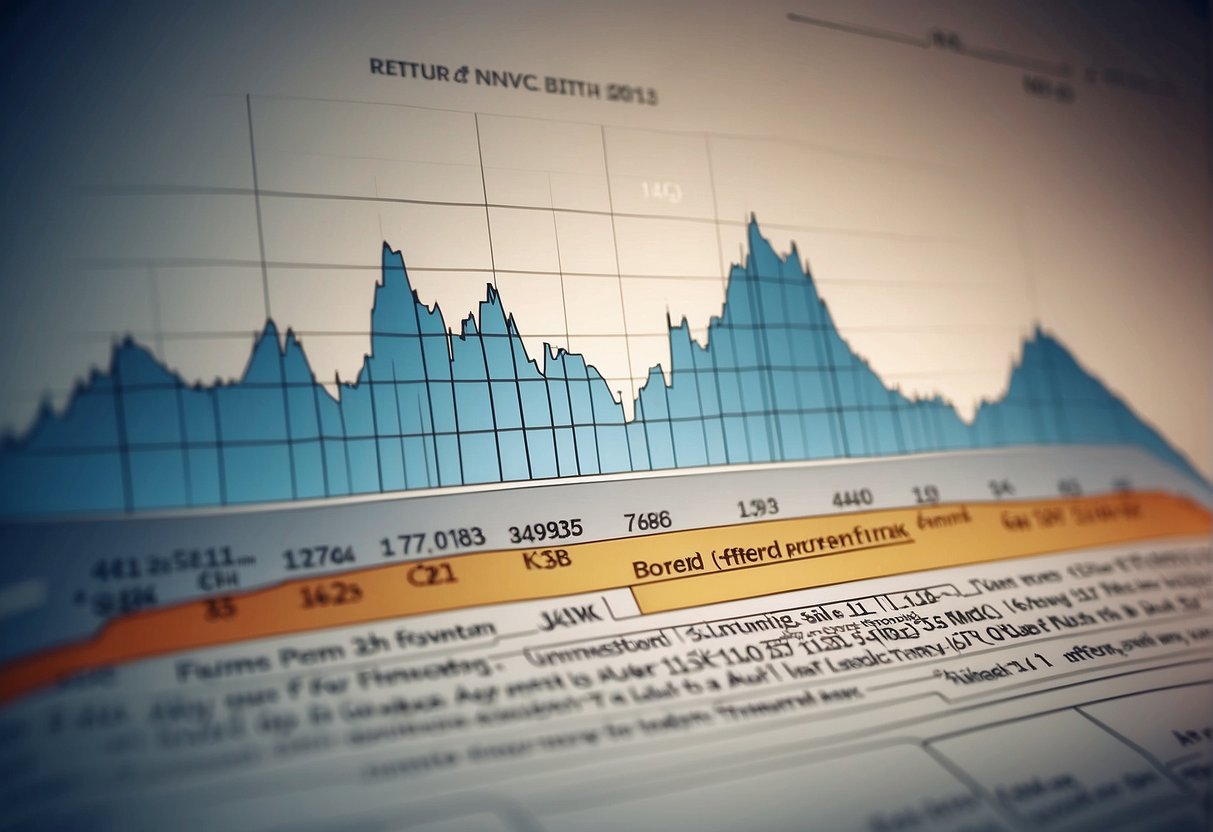Trend timing is a commonly utilized investment approach to capitalize on market trends to optimize stock market returns. Investors who employ this strategy seek to identify and benefit from trends, entering the market when it’s rising and exiting when it’s falling. Market participants can delve into the psychology of trend timing by utilizing technical analysis and behavioral finance principles to develop strategies that improve their returns.

This approach, however, is not without its risks. In addition to substantial market fluctuations, investors may be influenced by cognitive biases that can lead to suboptimal decision-making. To mitigate these risks, traders need to measure their trend timing success and consider the impact of the best and worst market days on their portfolios. Technological advances have further supported the development of successful trend timing strategies, and studying case studies can provide valuable insights into practical applications.
Key Takeaways
- Trend timing involves capitalizing on market trends to optimize returns in the stock market.
- Investors must be aware of the risks and potential cognitive biases in trend timing, employing technical analysis and behavioral finance tools to develop effective strategies.
- Technological advances and the success stories of experienced trend-timers can be beneficial in navigating different market conditions.
Understanding Market Timing
History of Market Timing
Market timing is moving investment money in or out of a financial market or switching funds between asset classes based on predictive methods. The concept of market timing has existed since the early days of stock trading, with roots dating back to the late 19th century. However, it gained significant attention in the 1970s and 80s due to technological advances and the growth of financial markets.
Market timing strategies have evolved over the years. These approaches can range from simple moving average crossovers to more complex models incorporating economic, technical, and sentiment indicators. While many investors have attempted to time the market in the past, the effectiveness of these strategies remains a topic of debate.
Market Timing Versus Buy-and-Hold
Comparing market timing to the buy-and-hold strategy is crucial for understanding the benefits and drawbacks of each approach. The buy-and-hold strategy is a long-term investment philosophy that involves purchasing and holding stocks for an extended period, regardless of market fluctuations. This approach is based on the belief that, over time, stock prices will generally rise and yield positive returns.
On the other hand, market timing involves making tactical decisions to enter or exit the market based on anticipated price movements. The rationale behind this strategy is that, if correctly executed, it can generate higher returns by capitalizing on short-term market trends.
There are numerous advantages and disadvantages associated with both strategies. The buy-and-hold strategy has the benefit of simplicity and requires less time and effort than market timing. Furthermore, it allows investors to take advantage of the historical trend of rising stock prices and the power of compounding. However, this approach can also expose investors to significant drawdowns during market downturns.
In contrast, timing can protect investors from market declines and capitalize on short-term trends. However, this strategy carries the inherent risk of missing out on significant gains if predictions about the market’s direction are inaccurate. Additionally, frequent trading can result in higher transaction costs and tax implications.
In conclusion, both market timing and buy-and-hold strategies have their merits and drawbacks. Ultimately, these approaches depend on the investor’s risk tolerance, investment goals, and willingness to manage their portfolio actively.
The Psychology of Trend Timing
Emotional Impacts on Trading
The psychology behind trend timing plays a significant role in the decision-making process of investors in the stock market. Emotions such as fear, greed, and overconfidence can heavily influence an individual’s ability to make sound trading decisions. When investors follow the current market trend, they may become more susceptible to emotional biases.
One of the primary emotional barriers traders face when attempting to time the market is the fear of missing out (FOMO). This fear can lead to impulsive buying or selling, causing traders to enter or exit positions incorrectly. Greed is another emotion that can affect trend timing, as it may cause traders to hold on to their positions for too long, hoping to generate higher profits.
In contrast, overconfidence can make investors underestimate risks associated with market fluctuations, leading to ill-timed decisions that wreak havoc on their investment portfolios.
Avoiding Emotional Pitfalls
To successfully navigate the stock market and improve returns through trend timing, it is crucial to implement strategies that reduce emotional influences on trading decisions. Here are some practical approaches investors can employ:
- Develop a trading plan: Establishing clear objectives and guidelines for trade entries and exits helps minimize the risks associated with emotional decision-making.
- Risk management: Allocating a predefined percentage of one’s portfolio to each trade ensures limited financial losses, reducing the emotional stress of trading.
- Maintaining discipline: Sticking to the established trading plan and avoiding impulsive decisions enables traders to navigate market fluctuations with a clear and neutral mindset.
- Seeking education: Continuously learning and staying informed about market trends and strategies helps improve one’s understanding of market dynamics and helps make more informed decisions, reducing the influence of emotions.
In summary, the psychology of trend timing is essential for investors looking to improve their stock market returns. By understanding the emotional impacts of trading and implementing strategies to avoid these emotional pitfalls, investors can make more informed decisions, better time the market, and ultimately enhance their financial success.
Trend Timing Strategies
Identifying Market Trends
Trend timing is a strategy investors use to improve stock market returns by identifying and following market trends. Market trends are often classified into bull markets, characterized by rising prices, and bear markets, characterized by falling prices. Investors use various technical and fundamental analysis tools to spot these trends and position their investments accordingly. Some popular technical indicators for identifying trends include moving averages, the Relative Strength Index (RSI), and the Moving Average Convergence/Divergence (MACD) [^1^].
In addition to technical indicators, investors keep an eye on key economic indicators and financial news to anticipate potential shifts in market sentiment. For example, if the economy shows substantial employment numbers and increasing corporate earnings, investors may expect a bull market and adjust their strategy accordingly.
Entry and Exit Points
Once a market trend has been identified, the next step in trend timing is determining the best trade entry and exit points. This aims to capitalize on the price movements associated with the trend, resulting in higher returns. Various tools and methods are used to identify optimal trade entry and exit points.
One standard method uses support and resistance levels, which are price levels where a stock is likely to change direction. When the price breaks through a support or resistance level, it could signal a potentially profitable entry or exit point. Traders also utilize chart patterns such as double tops, double bottoms, and head-and-shoulders to determine appropriate buying or selling points [2].
Another tool for determining entry and exit points is using stop-loss and take-profit orders. A stop-loss order is placed below the current market price to minimize losses if the trend reverses, thus protecting the investor’s capital. Conversely, a take-profit order is placed above the current market price to lock in gains when the price reaches a predetermined level [3].
Overall, trend timing strategies aim to improve stock market returns by capitalizing on the fluctuations in a dynamic market environment. Using technical and fundamental analysis tools, investors can identify market trends and appropriate trade entry and exit points. By following these strategies, investors have the potential to increase their overall returns while managing risks associated with market volatility.
Technical Analysis for Trend Timing
Chart Patterns
Technical analysis is a valuable tool for predicting future market movements in stock market investing. One crucial component of technical analysis is identifying chart patterns. These patterns give traders insight into potential market trends, helping them devise investing strategies to maximize their profits.
Classical chart patterns include:
- Head and Shoulders
- Double Top and Double Bottom
- Ascending and Descending Triangles
- Rectangles
These patterns can indicate the trend continuation or trend reversal in stock prices, which is highly relevant to market movements.
Technical Indicators
Another essential aspect of trend timing is employing technical indicators. Technical indicators are quantitative calculations based on price and volume data that provide traders with insightful information about market trends and patterns.
Some popular technical indicators used for trend timing are:
- Moving Averages (Simple, Weighted, Exponential) – This indicator provides a smoothed representation of price data over a specific duration of time, making it easier to spot trends.
- Relative Strength Index (RSI) measures the magnitude of recent price changes, helping traders determine whether a stock is overbought or oversold.
- Moving Average Convergence Divergence (MACD) – MACD is a momentum indicator that calculates the difference between two moving averages to identify divergences and convergences that potentially signal changes in a stock’s price direction.
- Bollinger Bands – This uses a range around moving averages to provide a relative definition of high and low values that can indicate potential entry and exit points in the market.
Using technical indicators effectively can help traders improve their stock market returns by identifying precise moments to enter or exit the market. These indicators enable investors to implement trend timing strategies that capitalize on market movements, aligning their portfolio positions with anticipated short-term and long-term trends.
With these tools, stock market investors can achieve improved returns by making informed decisions about when and how to adjust their portfolio allocations, ultimately increasing their profits and reducing their investing risks.
Behavioral Finance and Trend Timing
Behavioral finance is a subfield of economics that examines the psychological factors influencing investors’ decision-making process. It acknowledges that investors are not always rational and can be swayed by emotions such as fear and greed1. These emotions can often affect investment strategies and contribute to market volatility.
Trend timing is an investment strategy that seeks to capitalize on the overall market direction by analyzing historical price patterns. Investors using this approach attempt to identify trends and make buy or sell decisions accordingly. For example, if the market shows consistent upward movement, an investor employing trend timing might purchase stocks to exploit this bullish trend.
One key aspect of trend timing is understanding the impact of emotions on investors’ behaviors. During periods of market volatility, investors may exhibit irrational behaviors, like overreacting to news or failing to diversify their portfolios. By analyzing these behavioral patterns, investors can develop strategies to navigate the emotional pitfalls and potentially improve their stock market returns.
Trend timing often relies on technical analysis, which involves studying past market data to predict future price movements2. Technical analysts, sometimes called chartists, use moving averages, oscillators, and trend lines to detect trends and signals suggesting when to buy or sell securities.
In summary, the relationship between behavioral finance and trend timing involves recognizing the impact of emotions on investor behavior and their role in market volatility. By understanding this connection, investors can potentially employ trend-timing techniques to improve their stock market returns. Tools such as technical analysis provide valuable insights into historical price patterns, which can help investors make more informed decisions in volatile markets.
Footnotes
Measuring Trend Timing Success
Performance Metrics
To measure the success of trend timing in improving stock market returns, it’s essential to analyze specific performance metrics. The most common metric is the absolute return on investment, which represents the percentage change in the value of a portfolio between two periods. Another critical metric is the Sharpe ratio, which measures the risk-adjusted return. A higher Sharpe ratio implies that the investor generates higher returns for each unit of risk taken.
Additionally, investors can evaluate the success of their market timing strategies by monitoring the maximum drawdown, which represents the most significant decline in a portfolio’s value during a specific period. A lower maximum drawdown implies that the trend timing strategy has effectively reduced the potential for heavy losses. Monitoring these performance metrics can help investors determine the effectiveness of their trend timing strategies in improving their stock market returns.
Comparative Analysis
One valuable method for measuring trend timing success is through comparative analysis. By comparing the performance of their portfolio to various benchmarks, such as market indices or other investment strategies, investors can gain valuable insights into the effectiveness of their approach.
For instance, they can compare their trend-timed portfolio’s returns to those of a passive index-tracking portfolio, such as one that follows the S&P 500 index. If their trend timing strategy yields better returns with similar or lower risk levels, it indicates its relative success.
Another valid comparison is with other market participants who employ different investment strategies. This can give investors a more comprehensive idea of how their trend timing approach stacks up against the overall market, potentially revealing strengths and weaknesses in their methodology.
In conclusion, measuring trend timing success involves analyzing specific performance metrics and conducting comparative analyses to evaluate the strategy’s effectiveness in generating higher returns with manageable risk levels. By monitoring these factors, investors can continuously fine-tune their approach to enhance their stock market returns.
Risks of Trend Timing

Trend timing is a strategy investors use to capitalize on market trends and improve portfolio returns. While it may appear attractive, there are inherent risks associated with this approach. These risks include market volatility, unexpected economic events, and potential capital gains taxes.
Market Volatility: Markets can be unpredictable, and short-term fluctuations can lead to losses for trend-timing investors. Volatility is particularly concerning for those who frequently employ leveraged positions or trade, as it increases the probability of losses and the likelihood of getting whipsawed when the market reverses course after a trade is executed. The timing risk associated with trend timing can result in missed opportunities or increased trading costs.
Unexpected Economic Events: Another risk factor in trend timing is unforeseen events that can impact the market, such as changes in governmental policies, natural disasters, or geopolitical tensions. These events can lead to rapid market movements, catch investors off-guard, and result in significant losses. Trend timing strategies often struggle during market turbulence since it can be difficult to accurately predict the magnitude and duration of the associated price changes.
Capital Gains Taxes: Active trading associated with trend timing may lead to higher short-term capital gains taxes for investors. In many jurisdictions, short-term capital gains are taxed more than long-term gains. This tax burden can erode any potential benefits of trend timing and, in some cases, can negate the overall performance advantage gained by the strategy.
To mitigate these risks, investors considering trend timing should:
- Diversify their investments to reduce the impact of market volatility on their portfolio.
- Remain flexible and informed about any potential changes to the economic landscape that could impact the market or their investments.
- Factor in any potential capital gains taxes when evaluating the potential benefits of trend timing.
In summary, while trend timing can potentially improve stock market returns, investors must know the inherent risks. Careful consideration of market volatility, unexpected economic events, and capital gains taxes is essential to making informed decisions regarding this investment strategy.
Mitigating Risks in Trend Timing

Trend timing can help investors improve their stock market returns by capitalizing on market fluctuations. However, this strategy also involves certain risks. This section covers two fundamental approaches to mitigate these risks: Diversification Strategies and Contingency Planning.
Diversification Strategies
Diversification is a crucial component of risk mitigation for any portfolio. Investing in a mix of assets can spread the risk across various sectors and types of investments. This ensures that a downturn in one industry does not significantly impact the overall portfolio value. Some popular diversification strategies include:
- Asset allocation: Investors can allocate their capital across different asset classes, such as stocks, bonds, and commodities, to reduce concentration risk.
- Sector diversification: Spreading investments across various industries, such as technology, healthcare, and finance, allows investors to minimize the risk associated with sector-specific events.
- Geographical diversification: Allocating funds in different countries or regions can help mitigate political, regulatory, or economic risks in a particular area.
- Exchange-Traded Funds (ETFs): ETFs are an easy and effective way to diversify a portfolio. By investing in an ETF, investors can gain exposure to a broad range of securities across various market segments, reducing their overall investment risk.
Contingency Planning
Apart from diversification, contingency planning is another essential aspect of mitigating risks in trend timing. It involves creating a plan to address potential challenges and uncertainties impacting a portfolio’s performance. Some crucial components of a contingency plan include:
- Risk assessment: Investors should regularly assess their portfolio holdings, considering market volatility, economic scenarios, and sector risks.
- Stop-loss orders: By setting them, investors can limit their losses if the market moves in an unfavorable direction.
- Rebalancing: Review and adjust a portfolio’s asset allocation and individual holdings to adhere to the investor’s risk tolerance and objectives.
- Performance monitoring: Regularly monitor and evaluate the performance of the investments and the overall portfolio against the desired benchmarks.
By using diversification strategies and contingency planning, investors can effectively mitigate potential risks associated with trend timing. When combined with in-depth analysis and research, these approaches enhance their ability to achieve long-term financial goals.
The Impact of Best and Worst Market Days

Successful timing of the markets is a challenge for investors, as it involves predicting future market trends with accuracy. The impact of the best and worst market days plays a significant role when using trend timing to enhance stock market returns.
Market performance has evolved with a mix of bull and bear markets. During bull markets, stocks experience sustained growth, while bear markets witness falling stock prices. Investors often attempt to capitalize on these trends, but finding entry and exit points within these market conditions is crucial to maximizing returns.
Equally important is considering the risk of sitting on the sidelines during significant market moves. Missing out on the market’s best days can substantially decrease an investor’s cumulative returns. For example, a study by Visual Capitalist demonstrated that missing out on just the 25 best-performing days in the market over 20 years can cut potential returns by more than half.
Moreover, the impact of the best and worst market days becomes magnified during heightened volatility. For instance, the Wells Fargo Investment Institute explains that attempting to time volatile markets can lead to amplified risks. In other words, while an investor catching the best days can revel in considerable gains, exposure to the worst days can lead to significant losses.
In summary, trend timing involves navigating the complex confluence of market highs and lows and the impact of the best and worst market days. Developing a keen understanding of these factors and their effects on returns can be vital for investors looking to enhance their stock market performance through trend timing methods.
Long-Term Trend Timing and Retirement Planning

Long-term trend timing is a strategy that aims to optimize investment returns by making portfolio decisions based on analyzing historical trends in the U.S. market. It seeks to identify and capitalize on recurring market patterns to enhance the performance of an individual’s retirement portfolio while minimizing risks associated with market fluctuations.
One of the critical aspects of long-term trend timing is its focus on the market’s overall direction rather than short-term price fluctuations. Investors who deploy this strategy often rely on a mix of key market indicators, such as moving averages and market breadth, to determine when to enter or exit investments. By doing so, they attempt to capture the benefits of bullish markets while minimizing exposure to bearish trends.
A well-diversified portfolio plays a significant role in realizing the potential of long-term trend timing. Investors typically design their portfolios to include a mix of asset classes, such as stocks, bonds, and cash equivalents. This approach ensures that different assets respond differently to market conditions, offering more consistent returns and reducing the overall risk associated with the strategy.
Dollar-cost averaging, or consistently investing a fixed amount in the market at regular intervals, is another tactic that complements long-term trend timing. This method helps mitigate the risks of market timing by ensuring that investors consistently participate in the stock market without the need for precise entry or exit points.
Long-term trend timing can be valuable for retirement planning when combined with a diversified portfolio and a systematic investing approach. By focusing on the long-term trends in the U.S. market, investors can potentially optimize their returns while minimizing the risks associated with market volatility.
Trend Timing in Different Market Conditions

Bull Markets
In bull markets, trend timing can be particularly beneficial when stock prices are consistently rising. Investors can capitalize on upward trends by identifying stocks with solid momentum. Additionally, market participants can manage their portfolio risk more effectively by adjusting their exposure to specific sectors and identifying stocks with solid fundamentals. For instance, during a bull market, investors may focus on companies in high-growth industries or those with stable earnings growth. Implementing trend-following strategies, such as moving averages, can help monitor market trends and make informed decisions.
Bear Markets
Conversely, when stock prices are generally declining in bear markets, trend timing becomes crucial in preserving capital and minimizing losses. Investors can focus on establishing defensive positions by identifying stocks with lower volatility or those that tend to outperform in such market conditions. Trend-following indicators, such as moving average crossovers and relative strength index (RSI), can be applied to determine when to reduce exposure to the stock market.
During periods of market volatility, trend timing helps investors navigate the choppy waters by identifying crucial turning points in the market. This allows them to either enter or exit positions more timely and better manage their portfolio risk. Some trend timing tools to consider during high market volatility include the VIX (volatility index) and Bollinger Bands, which provide valuable insight into the market’s fluctuations and potential reversals.
Trend timing can offer a valuable edge in both bull and bear markets. However, investors must be prepared to adapt their strategies depending on market conditions and remain disciplined. By embracing a clear and objective method to assess trends, they can better navigate various market environments and improve their investment outcomes.
Technological Advances and Trend Timing

Technology’s continuous development has significantly impacted various aspects of human life, including how investors handle their stock market decisions. In this section, we will explore two critical technological advances that have proven to be game changers in trend timing: Algorithmic Trading and Artificial Intelligence and Analytics.
Algorithmic Trading
Algorithmic trading is a process that involves using automated systems to execute a large number of orders in the financial markets at rapid speeds. This technology has been highly beneficial for investors, particularly in trading tech stocks. With the help of algorithmic trading, market participants can analyze complex patterns and uncover investment opportunities faster than traditional methods. Some advantages of using algorithmic trading include:
- Reduced execution time: Orders are executed almost instantly, allowing investors to capitalize on brief market opportunities.
- Lower costs: Algorithmic trading can minimize transaction costs, eliminating the need for intermediaries.
- Reduced human error: Automated systems work more precisely and are less prone to making mistakes than manual intervention.
Artificial Intelligence and Analytics
Another technological advancement that has revolutionized trend timing in financial markets is artificial intelligence (AI) and advanced analytics. AI-driven platforms help investors to:
- Identify trends: Advanced analytics algorithms can process vast amounts of data and identify trends and patterns that may be difficult to spot using traditional analysis techniques.
- Make predictions: Machine learning models can assess historical data and predict trade about the direction, aiding investors in their decision-making process.
- Minimize risks: By incorporating real-time data and market analytics, investors can assess potential risks and adjust their strategies accordingly.
For example, investors looking to trade tech stocks can utilize AI-based analytics tools to assess the stock’s performance, make informed decisions, and potentially improve their returns.
In conclusion, technological advancements, such as algorithmic trading and artificial intelligence-based analytics, have played a crucial role in helping investors capitalize on market trends. By leveraging these technologies, market participants can enhance their decision-making process, improve stock market returns, and gain a competitive edge in the ever-evolving world of finance.
Case Studies: Successful Trend Timers

Some individuals have successfully utilized trend timing in investing to enhance their stock market returns. Trend timing is a strategy that involves identifying and capitalizing on prevailing market trends to optimize investment returns. It’s essential to remember that while some investors have succeeded with this method, it does not guarantee profitable results for every investor.
One notable example of a booming trend-timer is Paul Tudor Jones, a seasoned hedge fund manager. Jones made a fortune by predicting the Black Monday stock market crash in October 1987. By implementing market timing strategies and rigorous technical analysis, he was able to leverage his investments and profit significantly from the market downturn.
Another investor who capitalized on trend timing is George Soros, a well-known investor and philanthropist. Soros earned his reputation as “The Man Who Broke the Bank of England” when he bet against the British pound in 1992. By thoroughly understanding the currency market trends and deploying market timing techniques, Soros profited handsomely from his investments, ultimately resulting in the currency’s devaluation.
Market timing also extends to algorithmic trading, where computer algorithms identify and exploit market trends. These systems can execute trades ultra-fastly, capitalizing on even the most fleeting market opportunities.
In summary, the successful application of trend timing strategies has yielded impressive rewards for several prominent investors. These investors have optimized their return on investment by carefully analyzing market trends and implementing calculated timing tactics. However, it is crucial to remember that the success of trend timing relies heavily on the individual’s knowledge, experience, and ability to predict market tendencies accurately.
The Future of Trend Timing in Investing
As the investing world continues to evolve, trend timing is a significant strategy to navigate financial markets successfully. Harnessing the power of market trends can help investors capitalize on individual stock movements and broader market shifts, such as those in the Dow Jones Industrial Average, Russell 2000, or leading tech companies like Amazon.com and Apple.
The role of emotions in investing is a critical factor to be considered when utilizing trend timing strategies. By identifying and mitigating emotions, investors can remain focused on their long-term objectives without succumbing to impulsive decision-making. This is particularly crucial when responding to market volatility or fluctuations that might otherwise incite panic or irrational behavior.
There are several tools and investment approaches available to support trend timing. For example, investors may use:
- Moving averages
- Technical indicators like the Relative Strength Index (RSI)
- Trend lines and chart patterns
- Economic news and sentiment analysis
By employing these methodologies, investors can detect emerging stock trends like Amazon.com and Apple or the broader market indexes like the Dow Jones Industrial Average and Russell 2000. Investors can benefit from increased returns and market efficiency by watching trend shifts and taking decisive action.
It is essential, however, to remember that trend timing is not a foolproof method for improving stock market returns. Challenges like market unpredictability and external shocks can lead to incorrect trend assessments or missed opportunities. Thus, it is fundamental for investors to maintain a balanced approach combined with other investing principles like diversification and risk management.
In conclusion, the future of trend timing in investing will continue to evolve in tandem with financial markets. By mastering trend timing techniques and harnessing their potential, investors can take control of their financial destiny and unlock exciting new opportunities in the ever-changing landscape of the stock market.
Frequently Asked Questions
What strategies are successful for timing stock market trends?
Investors use several strategies for timing stock market trends, including moving averages, relative strength, and contrarian indicators. Moving averages involve analyzing the average price of an asset over a specified period to identify trends in Investor’s Buthe siness Daily. Relative strength compares an asset’s performance to the overall market. Contrarian indicators involve identifying assets that have moved too far in one direction and are due for a reversal.
Can you provide an example of effective market timing?
One example of effective market timing is using the 50-day moving average. If a stock’s price crosses above the 50-day moving average, it may signal a buying opportunity, while if the price crosses below, it could indicate the need to sell. However, it should be noted that no single strategy is foolproof, as market timing depends on various economic factors and investors’ preferences.
How can investors stay ahead with timing the market versus long-term investment?
While timing the market can lead to significant gains, balancing this approach with long-term investment strategies is essential. One way to accomplish this is by using a tiered approach, as described by Investor’s Business Daily, which involves allocating various portions of a portfolio to different market timing techniques while maintaining a substantial portion dedicated to long-term investments.
What statistical evidence supports the effectiveness of market timing?
Although market timing can be challenging, evidence supports its effectiveness. For example, Visual Capitalist found that an investor who missed the ten best days in the market would have reduced their portfolio value by over 50%. This suggests that successful market timing can lead to significant increases in portfolio value.
How did timing-related scandals in mutual funds impact investor strategies?
Timing-related scandals in mutual funds have led to increased scrutiny, tighter controls, and more transparency within the industry. As a result, many investors now prefer exchange-traded funds (ETFs) over traditional mutual funds, as ETFs typically offer lower fees and more flexibility when trading. This shift toward passive investment vehicles has also made it more difficult for active managers to outperform the market consistently.
What are the limitations of market timing within retirement accounts such as a 401k?
Market timing within retirement accounts like a 401k can be limited due to restrictions placed on trading frequency or the types of assets available for investment. Additionally, market timing may not be suitable for all investors, as it requires a high level of market knowledge and constant monitoring of economic trends. This is why a diversified, long-term investment strategy is often recommended for retirement accounts.
Conclusion
In summary, trend timing is a strategy that investors use to improve their stock market returns by following and anticipating market trends. One standard method of trend timing involves analyzing moving averages, which smooth out price fluctuations and provide a clearer view of the market direction. This allows investors to decide when to enter or exit a particular investment.
Another technique is the Growth and Trend method, which has demonstrated strong performance compared to the overall market. This strategy focuses on identifying periods of economic growth and following market trends to maximize returns while minimizing risk.
It is important to note that while some investors have found success with trend timing strategies, others argue that the best approach is to stay invested for the long term, as timing the market can be complex and unpredictable. Additionally, the effectiveness of trend timing can vary based on an individual’s expertise and experience.
In conclusion, trend timing can be used as a tool for investors looking to improve their stock market returns, but it should be employed with caution and a clear understanding of its limitations. Building a diversified investment portfolio and maintaining a long-term perspective remain crucial aspects of successful investing.




